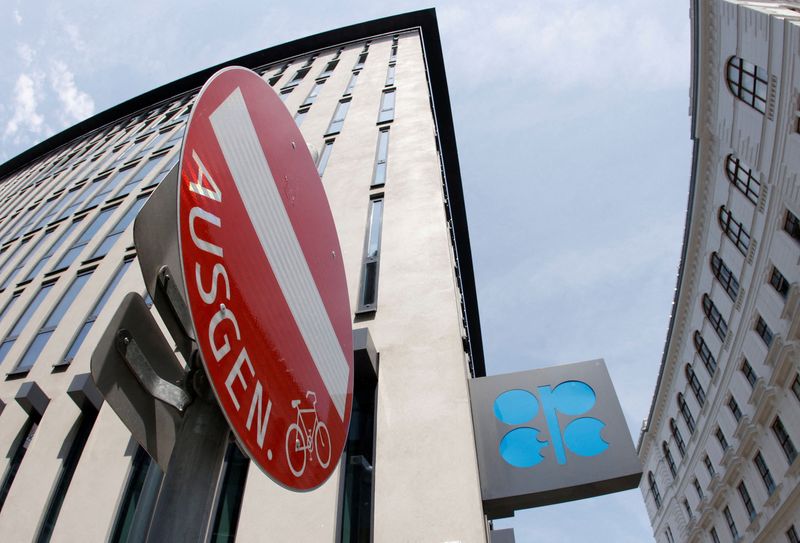Explainer-Why calls for oil embargo on Israel are unlikely to go anywhere
2023.11.21 10:34

© Reuters. FILE PHOTO: A view shows the logo of the Organization of the Petroleum Exporting Countries (OPEC) on their headquarters in Vienna, Austria, June 2, 2023. REUTERS/Leonhard Foeger/File Photo
By Ahmad Ghaddar
LONDON (Reuters) -Israel’s military offensive in Gaza following an Oct. 7 attack by the enclave’s ruling Islamist group Hamas has raised calls in the Middle East, particularly from OPEC member Iran, for using oil as a weapon to punish Israel.
The conflict has led many analysts, oil market watchers and politicians to draw parallels with the 1973 OPEC embargo, when Arab oil producers cut off oil exports to several allies of Israel, including the United States and Britain, following the Israeli-Arab war that year.
Analysts and OPEC sources, however, say that the energy world today is far different from 50 years ago, and play down any possibility of a new embargo.
The Organization of the Petroleum Exporting Countries and its allies led by Russia, or OPEC+, meet in Vienna on Sunday to decide on output policy, and sources have told Reuters that additional output cuts are likely to be discussed.
WHERE ARE CALLS FOR EMBARGO COMING FROM?
Last month, Iranian Foreign Minister Hossein Amirabdollahian urged members of the Organisation of Islamic Cooperation (OIC) to impose an oil embargo and other sanctions on Israel and expel all Israeli ambassadors.
Four sources from OPEC, which produces a third of the world’s oil and includes several Muslim states including Iran, told Reuters at the time that no immediate action or emergency meetings were planned by the group in light of Iran’s comments.
On Sunday, Iranian Supreme Leader Ayatollah Ali Khamenei appealed to Muslim states that have normalised relations with Israel to cut those ties for at least “a limited time”, weeks after he called for an Islamic oil and food embargo on Israel.
During a joint summit between members of the OIC and the Arab League in Riyadh on Nov. 11, Muslim states did not agree to impose wide-ranging sanctions on Israel, as requested by Iranian President Ebrahim Raisi.
WHAT HAPPENED BACK IN 1973?
In 1973, Arab OPEC producers led by Saudi Arabia imposed an oil embargo on the United States in retaliation for its support for Israel in the Middle East war in October of that year. The embargo, and subsequent output cuts, soon added other countries as targets, including Britain, the Netherlands and Japan.
The embargo led to severe shortages with long queues forming at gas stations. The negative impact on the U.S. economy was significant.
The embargo led to a spike in oil prices, but over the longer term the crisis encouraged the development of new oil sources outside the Middle East such as the North Sea and deepwater assets, as well as alternative energy sources.
WHY IS ANOTHER EMBARGO UNLIKELY?
While Western countries were the main buyers of oil produced by Arab countries a half century ago, nowadays Asia is the main customer for OPEC’s crude, accounting for about 70% of the group’s total exports.
“The geopolitical environment is different compared to 50 years ago,” one OPEC source said about why a new embargo was not in prospect.
“A 1970s-style oil embargo by the Gulf oil-producing states appears unlikely because two-thirds of GCC (Gulf Cooperation Council) oil exports today are purchased by Asian clients and, importantly, the economic transformation currently planned and implemented in the region requires a sustained absence of conflict,” JPM Morgan said in a note.
UBS analyst Giovanni Staunovo said that China’s influence in the Middle East is growing.
“China has brokered a deal between Saudi Arabia and Iran, and … is a very important client for Middle Eastern oil producers, the second largest oil consumer, and, together with India, the engine of oil demand growth.”
Morgan Bazilian, director of the Payne Institute, said the energy landscape has changed substantially over the past 50 years. “The U.S. is now the largest producer of oil and gas, and has a long-established strategic petroleum reserve.”








